I remember a time, only about 15 years ago, where community was those people closest to you, around you. They were people you interacted directly with face to face. Often times these people were like minded, and encouraging of free expression. This expression led to revolutionaries in the field of devotional art. Pre-internet, and more specifically, pre-social media the realm of devotional art was dynamic and highly personal, yet resonated with many who witnessed it. These visionaries include Rosaleen Norton, Maximilian Pirner, Johfra Bosschart, Aleister Crowley, William Blake, Oberon Zell, Paul Huson, and countless others I’m sure I am forgetting who inspired generations of occultists and polytheists through their work, often times defining cult imagery as we know it.
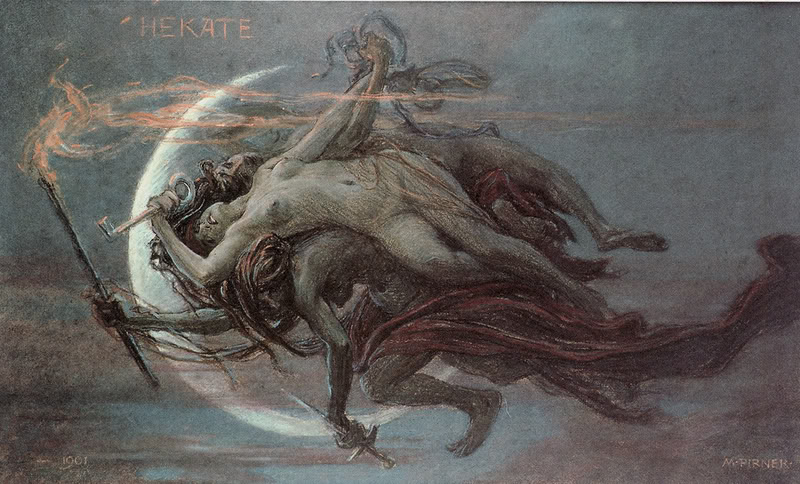
Now jump to 2020 and the world is connected more than it ever has been in its history. Community has now become a large interwoven net of individuals who have never met, nor interacted with one another in any capacity. This new community setting is being exposed to the very personal devotional work of artists all around the world, and true to form, they just have to say their piece about it, despite never knowing the artist or their work before seeing it in a group or on a page in the internet. These devotional artists, driven by their Eros to create, once hailed as revolutionaries, now witness their sacred work being mocked, picked apart, and scrutinized by internet shadows stuck in antiquated orthodoxy. The same holds true for those who share images they stumble across that speak to their Eros, that resonate with divine energy, they excitedly post it in their favorite groups just to have their devotional expression criticized and often shamed by people who have never once tried to get to know them or engaged in conversation on anything they posted in the past.
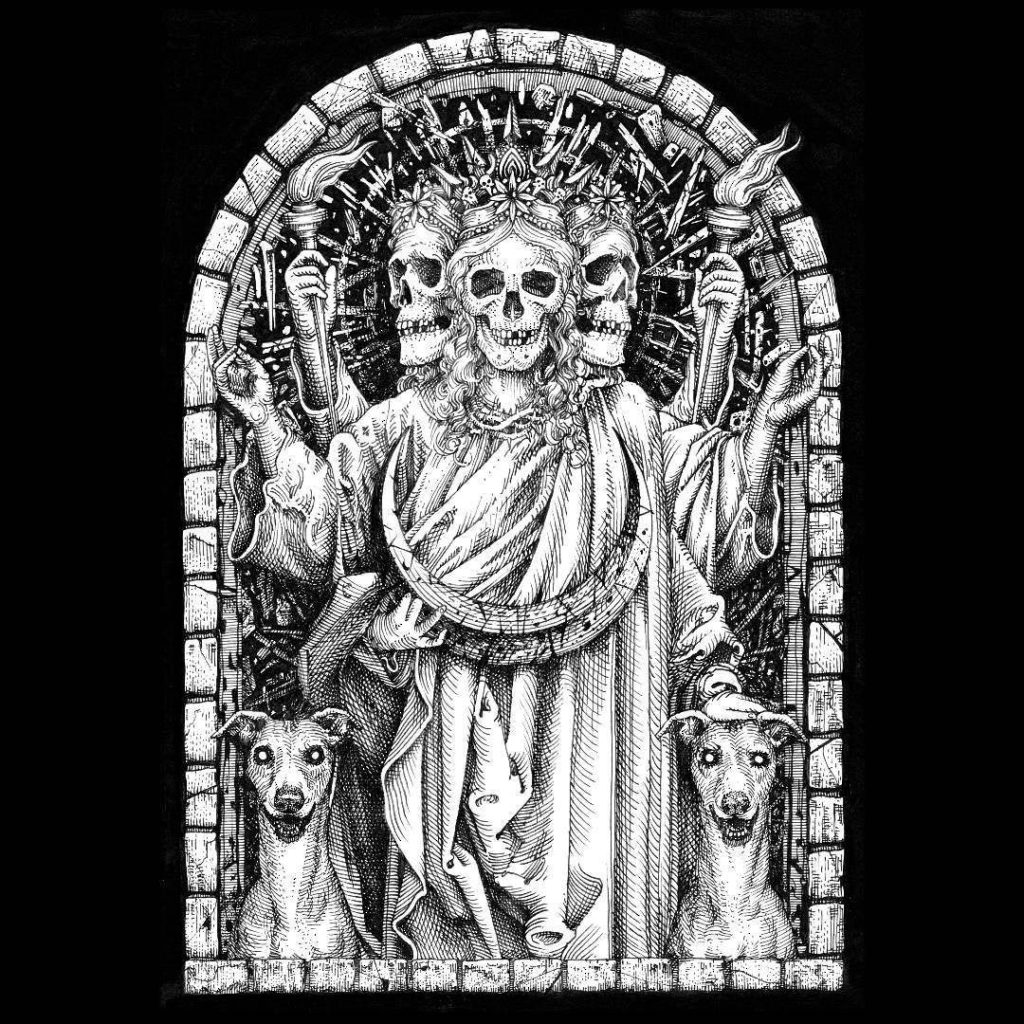
To put this post into context, as many know my work has been no stranger to the judgmental cries of orthodoxy, puritanical polytheists who debase my sacred images as “pornography”, or frivolous excuses to show nudity, proclaiming it devoid of divine inspiration. But this isn’t about my work this time. Recently in a group dedicated to the Goddess Hekate a member shared an image by the profoundly talented tattoo artist and illustrator, Felix De Kapitein that depicted Hekate with three skeletal faces. Reading the comments it seemed that many resonated with the image and connected with it, yet that didn’t stop the orthodox critics from jumping in to say their piece. The main argument of critics was that there is no ancient precedent for the depiction, and that to the ancient Greeks (mainly the Athenians where most of our scholarship comes from) found the worship of bones impure and offensive. This lead to an entire discussion I had with one woman in particular who debased all contemporary depictions that were not in line with her, or archaeology’s, catalog of devotional art as fantasy, and tricks of the artist’s mind, not guided in any way by genuine divine inspiration. To put her into context, she is an archaeologist who lives in Bulgaria, and is a member of a highly orthodox reconstructionist cult. When I have come across people who share the same sentiments on cult image as she does they typically fit into the same mold, often hailing from countries like Greece or Bulgaria, and members of reconstructionist cults that often do public re-enactments for tourists. I personally absolutely love these cults, what they do is beautiful, and authentic. What I don’t love is their profound need to police contemporary cult practice with zero tolerance for innovation or personal expression.
The three main talking points of these groups are:
- That there is no ancient precedent for certain images, citing the documented use of symbola in cult images, and lack of community acceptance.
- Ancient standards of what is acceptable would not allow such representations in cult, often proclaiming these images as blasphemy or offensive to the Gods.
- One cannot trust cult iconography that breaks from ancient tradition because it could be a malicious entity, that these images aren’t actually the God or Goddess they are suppose to represent.
I want to address these three talking points starting with number 1.
Ancient Precedent
Now, this is important. Personal contemporary cult does not require ancient precedent. I will say that again…. Personal contemporary cult does not require ancient precedent. For the orthodox, cult is static, unchanging over the past 2,000 years, as if the Gods Themselves had a cut off date for introducing new symbola. Unfortunately these individuals are narrowly confined to their own cultural bubbles that prevents them from appreciating the evolution of cult practices and images around the world.
So what is new symbola? It is any addition to the identifying traits representing a deity’s cult image. For example, symbola for Hekate would be 2 torches, keys, daggers, triple form, snakes, dogs, all those things that when you see an image you recognize it as Hekate. Most of ancient symbola comes from specific regional cult. For example, when Philip of Macedonia tried to invade Byzantium in 340 BCE, it is said Hekate illuminated the sky with Her torches revealing the position of the invading army, saving the city. As a result, new symbola, the star and crescent, were added to Her cult.
We also find symbola exchanged or shared with foreign Gods to show that the Gods are acting as one another. One of the best examples of this is the fusion God from Alexandria, Egypt, Hermanubis. Symbola from Hermes, such as the caduceus, is mixed with symbola of Anubis, such as the jackal head. We also see this with various forms of Isis (Hellenized Aset) Who takes the symbola of various Goddesses such as Aphrodite, Tykhe, and Demeter. How does this relate to contemporary cult? With the interconnectedness of the world today we are exposed to vast numbers of cultural and religious influences that move our Eros. We connect with our Gods through our own lens of experience. When we see another culture’s Underworldly Goddess, for example, one who serves Hekate may subconsciously search for similarities with these foreign Goddesses, and this symbola may start to find its way into personal cult, something that the ancients did regularly, in this case we see it with Hekate Ereshkigal. So it wouldn’t be surprising to find a Hekate cult with incorporated symbola from a cult such as Kali, or even one of the numerous Holy Death cults, most notably that of La Santisima Muerte. By incorporating this imagery it places a particular emphasis on Hekate’s role as psychopomp, Anassa Eneroi, Queen of the Dead.
I had a chance to talk to Felix De Kapitein, the artist of the skeletal Hekate, and asked him what the skeletal faces represented to him.
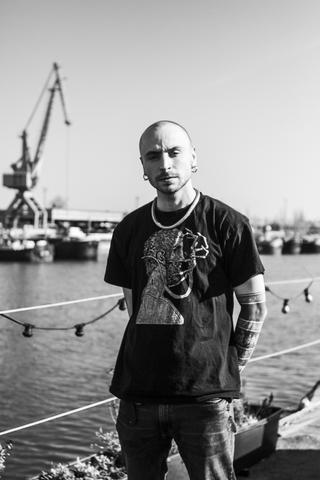
“I like to use skull faces in my work for characters who don’t live in the third dimension. So all mystical characters of beings who live beyond what we know as the physical world. For me this symbolizes all beings who are “living dead” as we can all transcend our physical bodies and are able to become this after we die (or choose to “die” as in spiritual enlightenment). In the Western world we have a fear of death, but in a lot of ancient civilizations death was seen as a way to transform consciousness. So all characters I show with skulls are living in the spirit world, where they transcend the idea of death.” – Felix De Kapitein
His profoundly spiritual perspective is influenced by ancient Eastern philosophy, something the ancients around the Mediterranean were no strangers to. Our exposure to culture is vastly superior to that of the ancient world and we as polytheists know the Gods are not static, that They still speak to humankind through symbola, and despite the thinking of the orthodox community, the language of new symbola does not have an expiration date. What is clear in this example is that Mr. De Kapitein has a profoundly deep understanding of the metaphysical interaction with the Divine and humankind. He manifests that understanding through the use of the skull in his work. If one were to emphasize the liminal, otherworldly, and physical and or spiritual death oriented cult of Hekate this representation is absolutely perfect with powerful symbola to represent it.
Like my iconography of Hekate as Queen of Witches, works like that of Mr. De Kapitein resonate with many in the community. This communal bond validates the symbola the iconography contains proving it to not be the personal whims of an artist, but rather a viable living representation of a Goddess Who speaks through the artist to Her devotees. It is quite worrying that there are those that feel they can interfere with this sacred and divine process simply because it doesn’t fit their agenda.
It isn’t just the ancient world where we find the practice of incorporating new symbola into devotional art. It is a huge part of contemporary folk religion, particularly religions like Catholicism. If we were to follow the spread of Catholicism we would discover that cultures all over the world preserved their traditions and identities by incorporating the symbola of saints into their worship. This is most evident in the African Diaspora Religions such as Lukumi and Vodou. These religions ingeniously grafted the images of the saints over that of their Gods utilizing inherently Christian symbolism making it their own. One such example is the use of the crucifix. As an example, in Haitian Vodou, when a cross is placed before a statue of Saint Lazarus who is used for Papa Legba, it becomes a symbol of the crossroads. When the cross is held aloft by Saint Expedite who is used for Bawon LaKwa, it represents the cross of the cemetery. I could go on and on about the use of Catholic symbola in various African Diaspora and pre-Columbian indigenous traditions, but that would take an entirely new blog post. What is important to know is that these religions don’t care about the opinions of outsiders, they don’t care about the anthropology or archaeology behind the meaning. They do it because they find beauty and meaning in it, and it connects them to their divine forces.
Ancient Standards
The next talking point is ancient standards of morality, ethics, purification, and spiritual pollution. This is often cited as a reason to debase contemporary iconography, particularly that which shows nudity or skeletal imagery. When we are addressing these issues through a Hellenic lens we are typically relying on an Athenian model of religious morality and ethics that was not the consensus of the Greek city-states as a whole. In fact, the conservative attitude of the Athenians was in stark contrast to the more liberal attitudes of Sparta and Arkadia. Needless to say, what was considered obscene and impure to the Athenians would have absolutely no relevance in modern contemporary society. In fact, much of Athenian life would be deemed problematic by today’s society, such as the lack of women’s rights, the bustling slave trade, human sacrifice, and allowing babies born with disabilities to die. To cling to ancient notions of morality and ethics is probably not the best idea in our modern world.
Morality and ethics aside, most ancient religious restrictions comes from a place of practicality. For example, dealing with the dead. Images of skulls and death are rare in Hellenic cult, and remains of humans or sacrificial animals was taboo to be left on the altar primarily for sanitation reasons. Decaying carcasses and cadavers made people sick. They smell, they bring pests, and overall they are not attractive to have lying around pristine marble halls of temples or laying on the altar. Human skulls in particular were especially taboo as we do not find them in temple art like we do the bucrania sculptures that adorn many Roman temples. This is because the ancients did not want to be reminded of their mortality when their life expectancy was so short, and it also the reason why they prized youth in art.
In the modern world many contemporary cults use the human skull for various reasons such as an appreciation for the natural and spiritual cycles of life, death, and rebirth, or as humbling reminders that life is temporary, that we all will die. We also live in an era where sanitation has come a long way and skulls rarely pose an actual threat to the health of the community and can be purchased as clean specimens, or in materials such as resin or natural materials. We also find that through interactions with various cultures who use skulls in cult iconography such as the Eastern traditions of Hinduism, or the Latin American cult of La Santisima Muerte, the symbolism of the skull is not so narrowly confined to that of the death fearing ancient Athenian.
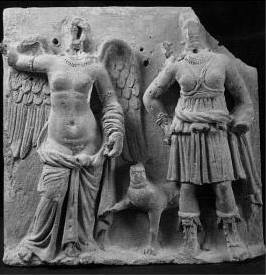
This is also true of iconographic nudity. In the art of the Mediterranean the nude form was prized, but only in certain scenarios. For one, the athletic body was the ideal and Gods were often depicted with chiseled bodies, nude, with favorable small genitalia prioritizing civility and intelligence over the baser sexual instincts. Conservative views on sex and sexuality are demonstrated most in the art depicting Goddesses. While almost every God was depicted nude at some point, few Goddesses were. Nudity in female iconography was reserved to Goddesses Who represent sexuality, maternity, or are untamed, earthly, and Underworldly, such as the Erinyes, Persephone, Selene, and Gaia. Again, these standards are very specifically Athenian as we do find a more liberal attitude outside of Athens, particularly when it comes to virginal Goddesses such as Artemis, Hekate, and Athena Who have been depicted with one of more breasts exposed.
But that was then. This is now. With the sexual liberation movement over the past half a century our attitudes toward nudity, especially as polytheists, has evolved greatly. We cannot hope to measure contemporary cult art by the archaic moral and ethical standards of male and female nudity the ancients held because they simply do not hold the same weight today as they did thousands of years ago. Female nudity has become a symbol of power, liberation, and nudity in general has become associated with witchcraft so it is especially relevant in witch cults, something the ancient Athenians scorned. When creating contemporary cult iconography that includes nudity, whether it is larger or realistic male genitalia or female nudity it is new symbola that is relevant to worshipers now, because we are living in the now. Just look at the keys contemporary artists give to Hekate. They certainly aren’t the large blocky poles of the ancients because that isn’t relevant to us now. The simple truth is if specific symbola are relevant to your personal cult, it is completely valid and should be reflected in your cult iconography.
Masquerading Entities
“Do not worship La Santisima Muerte! She is the Devil in disguise!”
The Church has long proclaimed any unsanctioned Gods and beings to be the Devil in disguise as a way to control the spiritual beliefs of their flock to keep the tight grip of power. Like the Church, one of the most frustrating talking points orthodox reconstructionists use is that the being that is being worshiped is not actually the God or Goddess, but some mysterious malevolent entity hell bent on infiltrating your personal cult to tap your energy and cause all the problems in your life. This is a tactic they adopted from the Church itself. It is a tool of oppression that is used to make sure nothing is done that is outside their personal preferences. Like the clergy of the Church these individuals typically have some kind of position of power, such as having some sort of degree in fields such as archaeology or anthropology. Although admirable, and although it sounds like they should have more say, there is one glaring point to be made: academia and practical religion are two very different things. While it is beneficial for every practitioner to be well versed in the scholarship behind their traditions and cult, it really is not a requirement. Catholics, Orthodox Christians, Hindus, Buddhists, Vodouisants, and followers of every other world religion most often do not care about the academic history of their religion, or how their religions were observed thousands of years ago. Neither should we. Just as their religions evolved and would be unrecognizable to their ancient counterparts, our cults should evolve as well. With orthodoxy, especially when it is rooted in academia, the Gods fit neatly and cleanly into definable boxes, and everything outside that box must be some malicious source because it does not conform to the standard of discovery that identified very specific cults 2 to 3 thousand years ago.
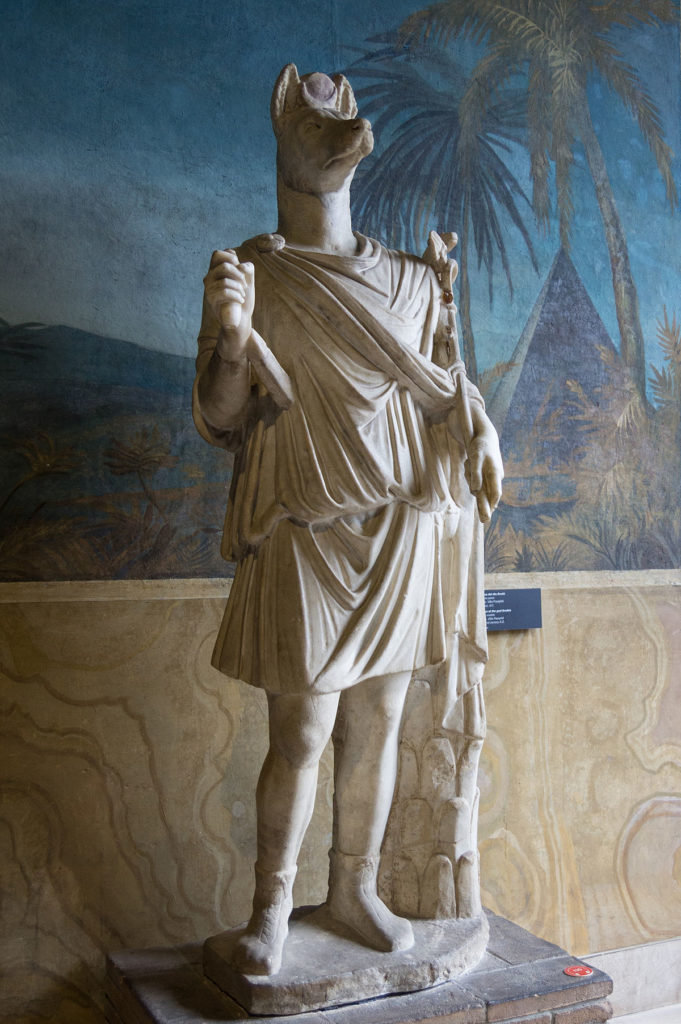
This notion of masquerading evil is a corruption of a common ancient practice of cult syncretism. This is a process typically involving deities “acting” as one another. Very clear evidence of this can be found in the examples mentioned before such as with Hermanubis. This God fusion is not unique, however. Again, Isis often becomes Tykhe, Aphrodite, and Demeter, or when Zeus becomes Amun, Gods sharing attributes and becoming one another. For Hekate, this is most common in the magical system of the Greek Magical Papyri where She is fused with Selene, the Furies, Persephone, Baubo, and Ereshkigal. Hekate Ereshkigal is one of my favorite occult epithets that I serve. She is Hekate acting as Ereshkigal, Hekate Who has become and is the same as Ereshkigal. So when I evoke Hekate Ereshkigal in my rites, it is like conjuring both Goddesses Who are then one. I do maintain a small shrine by my Hekate altar to serve Ereshkigal, as I know They are separate Goddesses but that does not stop Them from being the same in a ritual context. It is unfathomable that those who claim to be well versed in ancient cult would overlook such common and basic practices. Often these unique cult fusions are ridiculed by the orthodox and debased as fraudulent, that it is not “their Hekate”, but it is. It is also more than that. Not evil, but complex and full of purpose and symbolism.
One such case is in nude depictions of Hekate. Let’s say the symbola is not meant to represent any sort of witch cult, but this Hekate is sexual, seductive, and infernal. This could easily be seen as a Hekate Lilith that is either Hekate acting as Lilith, or Lilith as Hekate, equated with one another. One may protest that Hekate has nothing to do with Lilith, but as we know Hekate is equated with Krataiis, or Keto, Who either is or is the mother of Lamia, a sort of Hellenic Lilith. That and many contemporary cults equate Hekate with Lilith, or as Her mother, because we are indeed in a modern world and cult is an active force that lives alongside the people practicing them.
In a way they are right when they say that it is not “their” Hekate because quite frankly, She isn’t for them if they are outsiders of the cult She is representing. But to say She is not THE Hekate is hubris and shameful, especially to go on and say it must be some dark evil, adopting the scare tactics of the Church. Within this scenario they are the malicious entity, interfering with the Eros of others, interfering with that divine communication that inspires personal spiritual growth.
Do As Thou Wilt
It is not surprising that these quarrels over legitimacy are often between orthodoxy and polytheists who identify as witches. Because the orthodox typically have some root in their Christian counterpart (such as Greek Orthodox Christianity), and because they adopt an almost exclusively Athenian sentiment, they are often against witches and witchcraft much like the ancient Athenians were. They scorn it as superstition, or blasphemy against Olympus itself. This is because witches and our craft are untamed and uncontrollable. It is why witches have been feared for thousands of years. As we see from the casual gnosticism of the Greek Magical Papyri, and the expressive descriptions of the ancient poets, witches have been doing as we please with an entirely different understanding and connection with the Gods. We experience Them on a more cosmic level and that allows us liberties as we interpret omens, receive messages through dreams and visions, and have a blatant disregard for the opinions of the conservative orthodoxy because we understand our methods are not reliant on the opinions and approval of human beings, but instead, we are led by our Gods, and it is between us and Them.
So next time you connect with an unorthodox image of your Gods, and you share it, or create it, and others try to correct you, remember you owe no one an explanation. If they bark of what the ancients did, remind them that they may be content with sifting through the ruins for a how to guide circa 500 BCE, but you are in the present and what you do doesn’t have to be what the ancients did, it does not have to look the way theirs did, and it does not have to be weighed against the discoveries of academia. Trust in your Eros, trust in your Gods, and burn with the courage of your conviction that you are doing as your Gods guided you to do. Carry on the legacy of the Orphics, the Dionysians, and the Mystery Cults, who heard the voice of the Gods, celebrating the fringes of society, and explore new iconography that resonates with you like the visionary occultists and artists of our modern world. You do not require their permission or acceptance in anything you do. It is your personal cult and it is meant for you, not them. Let the potency of your cult and its iconography shake the judgement of the orthodox critics to their core, let it shake so strong that it is all you hear, drowning them out so they remain as they are: shadows on the internet.
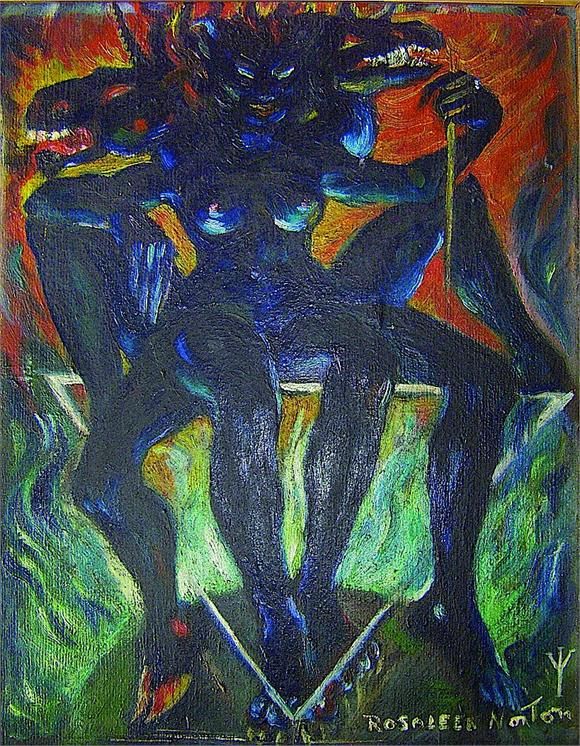

Great article! Every great truth is found in a great heresy. Historically when more people were illiterate, art served more of a didactic/educational purpose, more than for aesthetic enjoyment, it is a “living” entity, and as such – it evolves and grows. The Catholic Church commissioned gay French artists Pierre et Gilles, renowned for their kitsch & erotica to make contemporary depictions of many Saints. Nothing wrong with innovation at all – artistry is an act of devotion on the part of the artist, often when I produce images of deities – it is a meditative practise, I recite their mantras whilst doing so, in a semi meditative state – unfortunately – art can also be used as a tool of propaganda or to trivialise something & be disrespectful/sacrilegious, carrying out acts of “blasphemy” which again is evidence of how much power these representations are perceived to have. All of your art work is innovative & I’ve never seen a single piece of yours that might be considered “blasphemy” or sacrilegious – other pieces of religious art? That remains open to question.
100% agree with all of this and thanks so much for writing it! While I do feel that there should be one ‘home-image’ for any given deity (so that we all have the same starting point with them and their significations), I think it’s incredibly important that we find/create the form of that deity that rouses the most devotion in us because it’s the intensity and duration of our devotion that does the work in bringing us to that particular deity and them to us.
I also feel that nudity is sacred. Construct the genitals how you want but I think that they should be allowed to be shown and I think that there should be no difference between shown and concealed genitals in terms of permissibility. Naked deities, to me, show freedom and a transcendence of earthly cares and concerns. We cover ourselves up because we are ashamed; our deities shouldn’t be or why are we worshipping them? Their naked freedom helps us become more free within our own nakedness, as well as decentres sexuality as a concern more generally, which helps us become more free spiritually.
Thanks, Jeff! I appreciate your perspective, and I agree with it wholeheartedly! The imagery that speaks to me is simply the way that the gods speak to me, using the forms and symbols that are most meaningful to me.